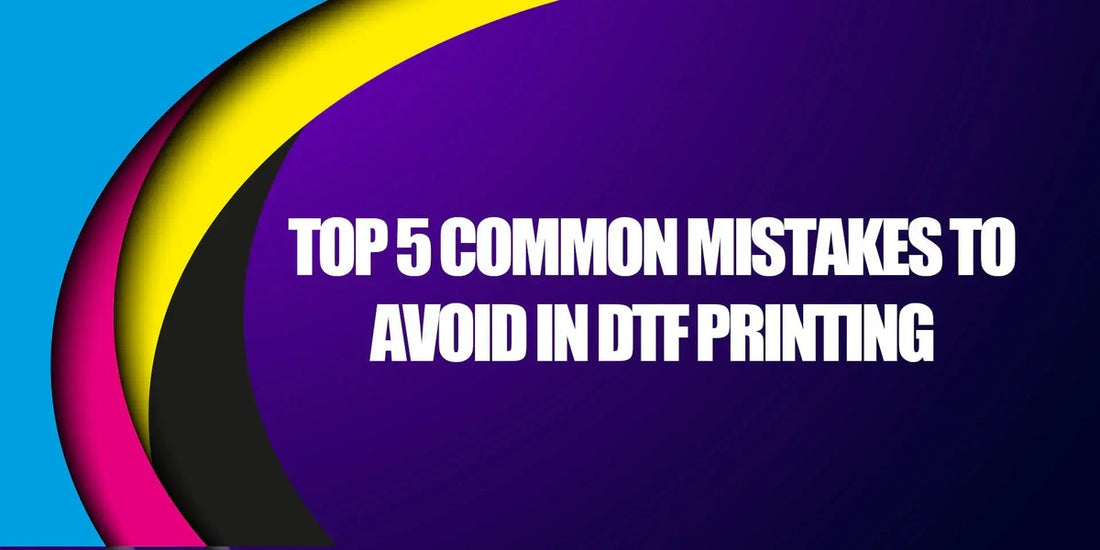Direct-to-Film (DTF) printing has revolutionized the textile printing industry with its ability to produce vibrant, durable, and cost-effective designs. However, like any technology, success with DTF printing depends on avoiding common pitfalls. Whether you’re new to DTF printing or looking to refine your process, understanding these mistakes can save you time, money, and frustration. Let’s dive into the top five mistakes to avoid in DTF printing and how to address them.
1. Using Low-Quality Materials
One of the biggest mistakes in DTF printing is compromising on the quality of materials, such as films, powders, and inks. While it may be tempting to cut costs, low-quality materials can significantly impact the final print's vibrancy, durability, and adhesion.
Why This Happens:
- Cheap inks can clog your printer's nozzles or fade quickly.
- Inferior transfer films may not release the design properly.
- Substandard powder may not adhere evenly, resulting in patchy prints.
How to Avoid:
- Invest in reliable DTF materials from trusted suppliers.
- Choose pigment-rich inks designed specifically for DTF printing.
- Test your materials before committing to large production runs.
2. Incorrect Heat Press Settings
The quality of your final print heavily depends on the heat press settings, including temperature, pressure, and time. Incorrect settings can result in designs that don’t adhere properly, are uneven, or lack vibrancy.
Why This Happens:
- Lack of understanding of material-specific settings.
- Relying on generic heat press recommendations instead of testing.
How to Avoid:
- Follow the manufacturer’s guidelines for the specific materials you’re using.
- Experiment with heat press settings on test prints to determine the optimal combination.
- Use a heat press with accurate controls for consistent results.
3. Neglecting Proper Printer Maintenance
DTF printers require regular maintenance to function optimally. Neglecting this can lead to print quality issues, such as banding, smudges, or nozzle blockages, which can delay production and increase costs.
Why This Happens:
- Overlooking the importance of regular cleaning.
- Not using the printer frequently, leading to ink drying in the nozzles.
How to Avoid:
- Schedule routine maintenance for your printer, including cleaning the printhead and ensuring proper lubrication.
- Use the printer regularly to prevent ink from drying.
- Store inks and other materials according to the manufacturer’s recommendations to maintain their quality.
4. Skipping Proper Artwork Preparation
DTF printing relies on high-quality artwork for the best results. Using poorly prepared or incompatible files can result in blurry, pixelated, or misaligned prints.
Why This Happens:
- Using low-resolution images or unsuitable file formats.
- Not properly adjusting the color profiles for DTF printing.
How to Avoid:
- Ensure your artwork is at least 300 DPI resolution.
- Use file formats like PNG or TIFF with transparent backgrounds.
- Adjust colors using software like Photoshop or Illustrator, and use ICC profiles tailored for DTF inks.
5. Improper Powder Application
The adhesive powder is crucial for transferring the ink to the fabric, but mistakes during this step can lead to incomplete transfers or uneven adhesion.
Why This Happens:
- Applying too much or too little powder.
- Not curing the powder properly before pressing.
How to Avoid:
- Spread the powder evenly across the design and shake off any excess.
- Cure the powder at the recommended temperature and time to ensure it melts uniformly.
- Invest in an automated powder shaker for consistent application in high-volume production.
Bonus Tips for Successful DTF Printing
To achieve consistent and professional results, keep these additional tips in mind:
- Understand the Limitations of DTF: While DTF is versatile, it may not be suitable for all types of fabrics or designs. Test your materials and adjust your process accordingly.
- Keep a Clean Work Environment: Dust or lint can interfere with the powder and transfer process, affecting the print quality.
- Stay Updated on Industry Trends: As DTF printing technology evolves, staying informed about new techniques, tools, and materials can give you a competitive edge.
Final Thoughts
DTF printing is a powerful tool for creating stunning, long-lasting designs, but its success depends on avoiding these common mistakes. By using high-quality materials, maintaining your equipment, and refining your process, you can ensure flawless prints every time. Whether you’re printing for personal projects or commercial production, these best practices will help you maximize your investment in DTF technology.
Are you ready to take your DTF printing to the next level? Avoid these pitfalls and watch your prints come to life with unparalleled quality and precision.
